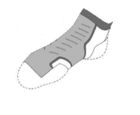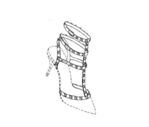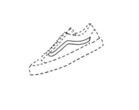Following up our previous article on the availability of position trademarks in Brazil that came into force on October 1st, 2021, by means of Brazilian PTO´s (BRPTO) Ordinance Nº 37/2021, the purpose of the present article is to present a review of the past two years of effective protection of this type of trademark in the country.
In these first two years, two hundred and seventy applications for position trademarks have been filed before the BRPTO, with forty-three rejections and only one grant. The remaining cases are pending or were withdrawn.
Before entering the merits of the first Brazilian decisions related to position trademarks in Brazil, it is worth clarifying in brief terms some relevant aspects of this trademark protection modality and how the examination for this type of mark is conducted in Brazil.
As per BRPTO´s Ordinance Nº 37/2021, a position mark is formed by the application of a sign in a unique and specific position of a given support, resulting in a distinctive overall impression capable of identifying products or services and distinguishing them from identical, similar or similar ones, provided that the application of the sign in the said position of the support can be dissociated from a technical or functional effect. This application to the support can be composed of any visually perceptible elements or their combinations, such as: words, letters, numbers, ideograms, symbols, drawings, images, figures, colors, patterns and shapes.
Regarding the analysis of the distinctiveness of the sign, BRPTO´s Ordinance Nº 08/2022 establishes that it must be carried out mainly under the distinctive potential of an overall impression resulted from the application of a sign on a particular support. The overall aspect shall contemplate the characteristics of: (i) uniqueness of the position (not being a position traditionally applied in trademark signs); and (ii) distinctiveness of the sign (capacity to distinguish itself from other existing marks in the same market segment). Note that the more unique the position applied in a sign is, greater will be the distinctiveness of the overall impression of the position trademark.
Based on the BRPTO´s decisions so far, the current scenario may lead us to believe that there is a certain strictness by the BRPTO in the application of the registrability rules, especially with respect to the distinctiveness and uniqueness characteristics of position trademarks, resulting in multiple rejections, and only a single grant decision by the BRPTO.
The granting decision dated May 30th, 2023, was obtained by the Brazilian clothing company TERRAS DE AVENTURA INDUSTRIA DE ARTIGOS ESPORTIVOS S.A – known by its trademark OSKLEN – which claimed protection for the position of three eyelets applied to the upper part of its sneakers, as follows:

According to the BRPTO´s decision, although the presence of eyelets (metal rings that limit the holes for air circulation) is common on the surface of sneakers, the marketing researches have not evidenced that other footwear companies use a sequence of three eyelets in the form proposed by the applicant, understanding, therefore, that the sign has distinctive character to act as a position mark.
On the other hand, many rejection decisions were rendered, based on the lack of the uniqueness and distinctiveness requirements, including the iconic decision dated May 30th, 2023, that rejected the application for the famous red Louboutin sole, owned by CLERMON ET ASSOCIES.
In this decision, the BRPTO understood that the sign does not comply with the requirement of distinctiveness, as it encompasses solely the red color applied to a women's high-heeled sandal. Against said decision, a Lawsuit has been filed before the Brazilian Federal Court on July 31st, 2023, which recently granted a preliminary injunction dated August 10th, 2023, staying the effects of the BRPTO´s denial decision.
It is also worth mentioning that the red Louboutin sole has been subject to many legal disputes around the world, and that the right to the position trademark was recognized by the Court of Justice of the European Union in 2018.
Other renowned applicants also had their position mark applications rejected by the BRPTO, such as Saf-Holland Gmbh, Valentino S.P.A., Veja Fair Trade Sarl and Vans, Inc., whose registrations had already been granted by the Industrial Property Offices of their country of origin or by offices from signatory countries of the Paris Convention.
We highlight below the legal grounds most applied by the BRPTO as basis for rejecting the concerned position marks´ applications:
- Composition of a trademark by the exclusive claim of a single color, without any other element that provides a distinctive character to the overall impression filed as position mark. Example of rejections:
- CLERMON ET ASSOCIES (with Lawsuit in progress):

(*) protection recognized by the Court of Justice of the European Union
- SAF-HOLLAND GMBH (within deadline for filing an appeal):

(*) protection recognized by the Germany Industrial Property Office
- Representation of a sign applied to a region of the support that has a predominantly technical or functional character. Example of a rejection case:
- APPLE INC. (within deadline for filing an appeal):

- The sign applied to the support that has an evidently ornamental aspect in its composition. Example of rejected cases:
- STRATEGIC BRAND GROWTH, LLC (no appeal filed – will be shelved):

- VALENTINO S.P.A. (waiting for a decision on appellate level):

(*) protection granted by the Italian Industrial Property Office
- VANS, INC. (waiting for an appeal decision):
- Failure to comply with the uniqueness requirement of the signal position on the support. Examples of rejected cases:
- VANS, INC. (within deadline for filing an appeal):

(*) protection granted by the Industrial Property Offices of Benelux, Italy, Ireland and Poland
- AIRWAIR INTERNATIONAL LIMITED (no appeal filed – will be shelved):

(*) protection granted by the Industrial Property Offices of Benelux, Denmark and France
- VEJA FAIR TRADE SARL (within deadline for filing an appeal):

(*) protection granted by the Industrial Property Offices of Benelux, Spain, France and Italy
Despite an apparently discouraging landscape regarding the recognition of position marks by the BRPTO, we cannot disregard that the decision that granted a position mark to OSKLEN sneakers opens space for other companies to seek the same recognition from the BRPTO.
Furthermore, from a legal standpoint, the application of registrability rules in connection with position marks in Brazil tends to change. The decisions that are expected soon, both in the administrative (pending a decision on appellate level) and judicial (such as the case of the Louboutin red sole, currently under judicial review at the Brazilian Federal Court) spheres, will certainly guide the future examinations on position trademark protection in Brazil.
In view of the above, we can only recommend Brazilian and foreign companies willing to register their position trademark in Brazil to have a clear understanding of BRPTO´s Ordinance Nº 37/2021, which established the rules on registering position trademarks in Brazil, and BRPTO´s decisions on the matter, as well as the corresponding judicial case law, in order to increase their chances of success in obtaining trademark rights over their position marks.
The content of this article is intended to provide a general guide to the subject matter. Specialist advice should be sought about your specific circumstances.


